

V24N3 - The Attack on Pearl Harbor - The Lessons for Today's Strategic Thinkers. The Attack on Pearl Harbor - The Lessons for Today's Strategic Thinkers by MAJ Seow Hwye Min The attack on Pearl Harbor has often been seen to be more than simply the opening blow of an epic contest in the Pacific between two great maritime powers.
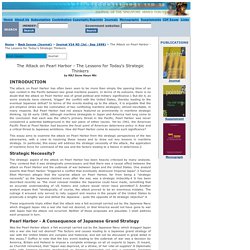
In terms of its outcome, there is no doubt that the attack on Pearl Harbor was of great political and military significance.1 But did it, as some analysts have claimed, 'trigger' the conflict with the United States, thereby leading to the eventual Japanese defeat? In terms of the events leading up to the attack, it is arguable that the pre-emptive strike was the culmination of two conflicting maritime strategies; almost inevitable, in many respects.
But Pearl Harbor had not always featured so prominently in maritime strategic thinking. This essay aims to examine the attack on Pearl Harbor from the strategic perspectives of the two adversaries, with a view to resolving these issues and to draw out key lessons in maritime strategy. Conclusion. Pearl Harbor and the back door to war theory. Intelligence Throughout History: The Impact of Pearl Harbor. Between the Revolutionary War and World War II, the United States lacked an established, professional,centralized intelligence organization.

Up until WWII, the country didn’t see the need for it. On December 7, 1941, the need for a centralized intelligence organization was clearly demonstrated when waves of Japanese aircraft swept from a clear sky to bomb U.S. PUB905.pdf. Pearl Harbor Review - Pearl Harbor - NSA/CSS. Writing some 15 years after the Japanese attack, William F.

Friedman said that the "Battle of Pearl Harbor is still being fought but the adversaries this time are all Americans. " This statement is almost as true today as it was in the 1950s. Pearlharbor.pdf. Attack on Pearl Harbor. Real reason Japanese attacked Pearl Harbor. Text smaller Text bigger By Victor Davis Hanson The Japanese did not see their attack on Pearl Harbor as foolish at all.
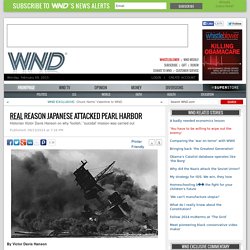
What in retrospect seems suicidal did not necessarily seem so at the time. In hindsight, the wiser Japanese course would have been to absorb the orphaned colonial Far Eastern possessions of France, the Netherlands and Great Britain that were largely defenseless after June 1941. The Attack on Pearl Harbor by Alan Zimm.
The Attack on Pearl Harbor: Strategy, Combat, Myths and Deceptions (Haverton, PA/Newbury: Casemate, 2011) by Alan D.
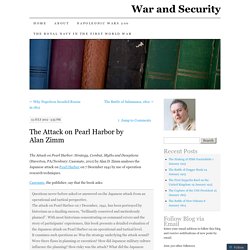
Zimm analyses the Japanese attack on Pearl Harbor on 7 December 1941 by use of operation research techniques. Casemate, the publisher, say that the book asks: Questions never before asked or answered on the Japanese attack from an operational and tactical perspective. The attack on Pearl Harbor on 7 December, 1941, has been portrayed by historians as a dazzling success, “brilliantly conceived and meticulously planned”. With most historians concentrating on command errors and the story of participants’ experiences, this book presents a detailed evaluation of the Japanese attack on Pearl Harbor on an operational and tactical level. Pearl Harbor's Overlooked Answer. The most important facet of the Japanese attack—the thing that made it so stunning—was the sheer number of aircraft involved.
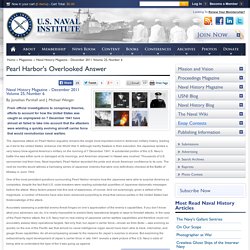
The Japanese did not just assault Pearl Harbor; they simultaneously hit every major airfield across the breadth of Oahu—Ewa Mooring Mast Field, Naval Air Station Pearl Harbor, Naval Air Station Kaneohe Bay, Wheeler Field, Hickam Field, and others—to remove American airpower as a threat to Kido Butai ’s carriers. Simultaneously hitting so many targets required massive numbers of planes—183 and 171 in the two attack waves. That was unprecedented. In fact, Kido Butai was a truly revolutionary weapon system for its time because it embodied the conceptual leap from single-carrier to coordinated multicarrier operations.
Pearl Harbor: Fifty Years of Controversy. Pearl Harbor: Fifty Years of Controversy Charles Lutton At 7:49 a.m. on Sunday, December 7, 1941, 183 Japanese dive- and torpedo-bombers, accompanied by Zero escorts, launched the first of two attacks against the American base at Pearl Harbor.
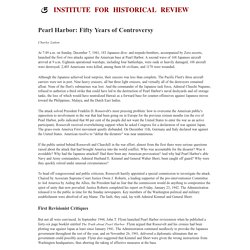
A second wave of 168 Japanese aircraft arrived at 9 a.m. Eighteen operational warships, including four battleships, were sunk or heavily damaged; 188 aircraft were destroyed. 2,403 Americans were killed, among them 68 civilians, and 1178 were wounded. Pearl Harbor (Dec 7, 1941) in World War II: Home Front. On 7 December 1941, Japanese planes attacked the American naval base at Pearl Harbor.

Today, the small island nation’s decision to wage war on the mighty United States seems incredibly foolish. But in 1941, it was not all that absurd. The Japanese had spent the 1930s expanding into Southeast Asia and developing a military strong enough for the job. The United States had spent the decade bogged down in economic depression and committed to avoiding the war brewing in Europe. The Japanese had more men in uniform (2.4 versus 1.5 million) and more planes (7500 versus 1200). The Japanese also benefitted from pursuing comparatively local objectives.
It is worth considering how events might have played out had Japan just continued to flex its expansionist muscles in Asia. But the Japanese high command decided in late 1941 to preempt any outside interference. So in late November, six aircraft carriers packed with 411 planes set off for Pearl Harbor. Speech Analysis: Franklin Roosevelt Pearl Harbor Address. On December 7th, 1941, Pearl Harbor was attacked by Japanese forces.

The next day, Franklin D. Roosevelt addressed the United States Congress with his memorable “a date which will live in infamy” speech. This speech had two purposes: To urge Congress to formally declare war on Japan (which they did just minutes later), andTo rally the American people to support the war effort.
In this speech analysis article, we focus on Roosevelt’s choice of words to see how they helped communicate his message. This is the latest in a series of speech critiques here on Six Minutes. A_new_view_of_pearl_harbor.pdf. War Warnings. Introduction The following extract from the Roberts Commission's finding of facts reveals ample shortcomings of Admiral Kimmel and General Short for the preparation of adequate defenses for the Pacific Fleet and Navy Base at Pearl Harbor.
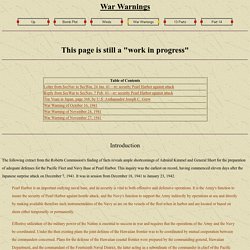
This inquiry was the earliest on record, having commenced eleven days after the Japanese surprise attack on December 7, 1941. It was in session from December 18, 1941 to January 23, 1942. Pearl Harbor is an important outlying naval base, and its security is vital to both offensive and defensive operations. Declassified Memo Hinted of 1941 Hawaii Attack - Washington Whispers. Three days before the Dec. 7, 1941 Japanese attack on Pearl Harbor, President Roosevelt was warned in a memo from naval intelligence that Tokyo's military and spy network was focused on Hawaii, a new and eerie reminder of FDR's failure to act on a basket load of tips that war was near. In the newly revealed 20-page memo from FDR's declassified FBI file, the Office of Naval Intelligence on December 4 warned, "In anticipation of open conflict with this country, Japan is vigorously utilizing every available agency to secure military, naval and commercial information, paying particular attention to the West Coast, the Panama Canal and the Territory of Hawaii.
" The memo, published in the new book December 1941: 31 Days that Changed America and Saved the World went on to say that the Japanese were collecting "detailed technical information" that would be specifically used by its navy. "So many mistakes through so many levels of Washington," said Shirley. "Some things never change. " THE PEARL HARBOR DECEPTION. A question of honor: After 59 years, military commanders may be exonerated of wrongdoing By William Brand For 59 years, the names of Adm. Husband Just before 8 a.m. on Dec. 7, 1941, Kimmel and Short watched as carrier-launched Japanese aircraft crisscrossed above the Hawaiian Islands, their bombs, torpedoes and bullets laying virtual waste to U.S. military installations, men and machines commanded by the two career officers.
Pearl Harbor bombed — History.com This Day in History — 12/7/1941. Pearl Harbor bombed — History.com This Day in History — 12/7/1941. Local historian recalls Pearl Harbor events. On the Sunday afternoon that shocked the Navy and America 73 years ago, many Pensacolians listened tranquilly to a symphony orchestra on the only local radio station, WCOA. But four time zones behind the Florida Panhandle, and 4,400 miles to the west, the Navy's battleship armada anchored at Pearl Harbor in Hawaii was being obliterated in a surprise raid by Japanese war planes. New research by local historian John Appleyard describes Pensacola Naval Air Station and the town that embraces it as shaken, but snapping to attention upon receiving news of the attack. "Within nine days the pilot training program at the base had moved from an existing schedule of 800 students per month to 2,500," Appleyard writes. His analysis, planned as part of a proposed local television documentary series, underscores the drama of the Japanese strike and the nationwide mobilization that quickly followed.
The Road to Pearl Harbor: The United States and East Asia, 1915–1941. Facts Summary Information. By Mark J. Perry Lieutenant Lawrence Ruff, USS Nevada‘s communications officer, rose early that Sunday. Attack At Pearl Harbor, 1941 - The Japanese View. World War II (1939–1945): Japan and Pearl Harbor. Events 1937 Japan goes to war with China. Attack on Pearl Harbor. 7 Dec 1941. How Roosevelt Attacked Japan at Pearl Harbor. Fall 1996, Vol. 28, No. 3 How Roosevelt Attacked Japan at Pearl Harbor Myth Masquerading as History By R.J.C. Butow © 1996 by R.J.C. Butow Larger Version. Pearl Harbor - World War II. The Japanese plan was simple: Destroy the Pacific Fleet. That way, the Americans would not be able to fight back as Japan’s armed forces spread across the South Pacific. The Japanese Attacked Pearl Harbor.